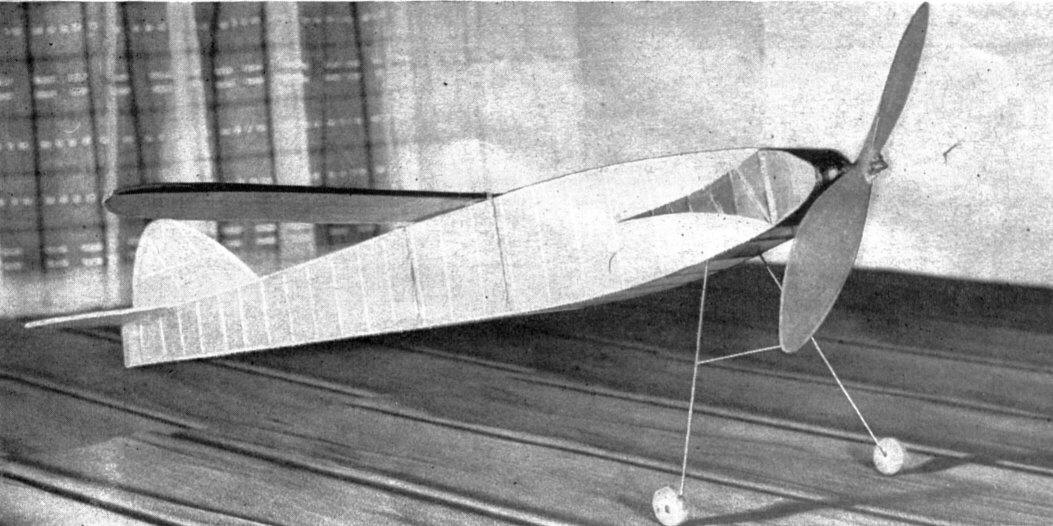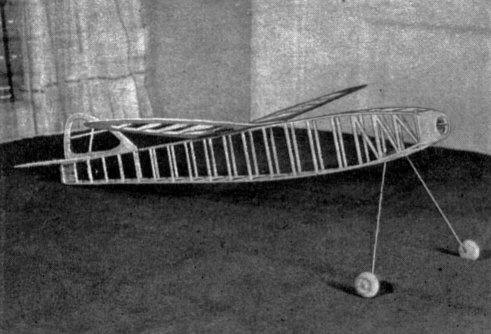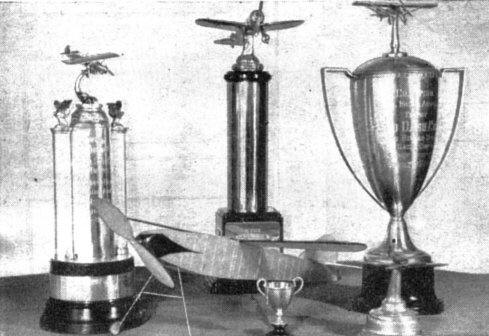|
SECRETS OF SPEED Information on flying and timing racing models; plans of typical ship.
THE greatest asset of modern air transportation is speed, and it is for this reason that the field is expanding so rapidly; therefore I feel that we should do more experimenting with speed models. Timing speed models accurately is the greatest drawback. In Cleveland we have an electromagnetic timing device. At the starting platform we have a button which causes the electromagnet to start the stop watch and another button at the finish line to stop the watch. The electromagnet is quite powerful and responds to the slighest touch of the button. Four large dry cells furnish the current for the electromagnet. This is not the most accurate way of timing speed models, as photoelectric cells would be absolutely accurate, but it would take a whole battery of them to cover the finish line. A stop watch with finer graduations would help, when using either method. We have been experimenting with speed models for about seven years around Cleveland, attaining speeds of seventy-five miles per hour. These tremendous speeds of between sixty and seventy miles per hour must be accurate; I have had wings rip off, due to the terrific pressure exerted on the wing when the ship climbs too steeply. The course used at the junior Aviator contests was eighty-eight feet long and thirty feet wide, it being an unofficial flight when the ship swerved out of the thirty-foot channel. In 1938 they doubled the length of the course, making it a hundred and seventy-six feet and increasing the width to fifty feet. On several occasions my ship flew twice the length of this extended course. Following are plans for a speed ship typical of those flown around Cleveland. FUSELAGE Build the two sides of the fuselage first, using either 1/16" square pine or 1/16" square plus hard balsa. Don't use balsa that is too brittle. Then assemble the sides with the top and bottom cross braces. Make the nose block of three pieces of medium-hard balsa. Cement the three pieces together and drill the 9/16" hole through the center. If a sharp drill is not obtainable, heat a round piece of metal, about 1/4" diameter, and burn a hole through the block, finishing up with sandpaper or a round file. After the block is drilled and cemented to the fuselage, fit the nose plug in the nose block, making the plug fit tightly, for this is very essential. Then round the corners of the nose block. The rear plug is built up of 1/16" flat hard balsa, with a rear hook of 1/16" diameter wire, which is so bent as to allow you to attach a winder to it. LANDING GEAR The landing gear is bent from .038 wire and cemented between two 3/32 x 3/16 x 1-5/8" pine blocks. The wheels are held in place with two brass washers which are cemented to the axles. WING AND TAIL SURFACES Cut the ribs from 1/32" flat balsa, according to the rib illustration. The leading and trailing edges and bottom spars are then pinned to your drawing, after which the ribs and top spars are cemented in place. The 1/16" flat balsa wing tips are cemented in place next. Make the leading and trailing edges and spars of full-length pieces, cracking them, instead of cutting them through, for the dihedral. The tail surfaces are made of medium-hard balsa. COVERING I find that yellow is the best color for speed models. Be sure to use a good grade of tissue, as there are some inferior grades. The grain of the tissue runs the same as the airstream, except on the wing, where it runs from tip to tip. Use a fairly thin mixture of nitrate dope, applying a number of coats on the fuselage, but only enough to keep the tissue taut on the wings and tail surfaces. Put the wash-in in the wing when the dope is drying. PROPELLER AND NOSE PLUG The propeller is the most important secret to a successful speed model. Great care must be taken to balance the propeller accurately, to outline the blades properly and also to get a smooth finish, as all these add to torque or drag. Use a 1/2 x 1 x 8" hardwood block, either spruce, mahogany, cherry or poplar. First lay out the propeller on a block using a good symmetrical design. Then drill a 1/16" hole for the shaft. Balance the prop after excess wood has been trimmed off. Carve back of propeller first, using about 1/32" undercamber. Then carve the front, but be sure not to get the blades too thin, as they will tend to bend under full power and will also be unable to take the shocks of rough landings. The blades should be about 1/16" thick, 1-1/2" from the tip. Sand and dope prop until you get a smooth finish. The nose plug is turned on a lathe, using the same kind of wood as on the prop. The brass bushings with 1/16" diameter hole may be purchased from the Cleveland Model Supply Co. One brass bushing is used on the back of the prop. The method of holding the prop to the shaft, shown in the prop shaft detail, is used to prevent the prop from wabbling. FLYING Test model in high grass, using about eight strands of 3/16" flat rubber, gradually increasing the number of strands until the most efficient prop speed is found. Remember, a prop that is turned faster than it is able to handle the air tends to lose its efficiency. I find that sixteen strands of 3/16" flat rubber are very satisfactory for the hundred-and-seventy-six-foot course. Editor's Note: Leonard Becker is a well known model builder around Cleveland, where he has both won and placed in a number of speed contests. In 1934 he won the speed event at the Scripps-Howard Junior Aviator Nationals with a speed of 48 miles per hour. Becker modified his design for 1935, bringing out a ship that weighed one and a half ounces without rubber. It clipped off 66.66 miles per hour over an 88-foot course. Dick Korda flew a ship of somewhat similar construction in 1936 at 70 miles per hour to win the Junior Aviator Races. At the eliminations, Korda had hit 75 miles per hour. The modern course is 176 feet. Last year three fliers were tied for first. Becker placed, as he has done for the last three years. He cautions builders to use hard wood for this ship and to be careful that it is not brittle. Scanned From September 1939 |


